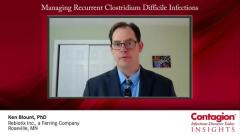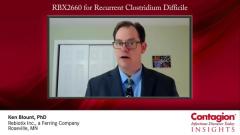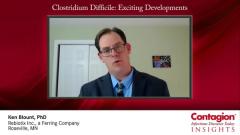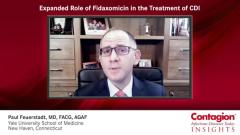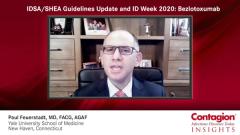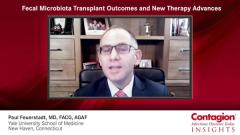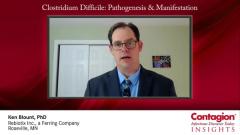
Risk Factors for Recurrence of Clostridioides Difficile
Episodes in this series

Transcript:
Paul Feuerstadt, MD, FACG, AGAF: When it comes to risk factors for recurrence, it’s important for clinicians to understand what they are, to identify which patients are at greatest risk. But the ultrastructure for the risk factors for recurrence emanates from the risk factors for initial infection.
Let’s first focus on the risk factors for initial infection. I put these in 3 categories. The first category is demographics: age over 65, female gender; any form of immune compromise, chronic kidney disease, HIV, inflammatory bowel disease, inflammatory bowel disease on a biological agent, rheumatologic disease; medications, including antimicrobials and acid-suppressive therapies, such as proton pump inhibitors [PPIs] and histamine blockers.
Why do antimicrobials leave patients at risk for initial, and of course recurrent, C difficile [Clostridioides difficile]? The best study that looked into this was published in 2008. It’s an older study but gives us a lot of information and was a foundational study. Within that analysis, they looked at 3 individuals who were controls: over 65 years of age, no C difficile infection, no oncologic diagnosis. They compared them with 4 individuals who had an initial episode of C difficile, and 3 individuals who had recurrent C difficile. They compared the microbiota between no infection and initial infection, and initial infection and recurrent infection. And what they found was that when they compared no infection with initial infection, there were no statistically significant differences in terms of the diversity of the microbiota, how variable it was, or the constituency, what was actually there. When they compared initial infection with recurrent infection, there were statistically significant differences, with a depletion of the diversity, less variability, and a depletion of the Bacteroidetes and the Firmicutes. Those phyla, the Bacteroidetes and the Firmicutes, are the 2 most important phyla preventing proliferation of C difficile infection.
We learned 2 things from that study; one was that with initial C difficile infection, patients have a bent microbiota but not a broken microbiota. When we treat this infection with antimicrobials, we’re targeting the bacteria with that initial treatment, but the microbiota most likely can regenerate itself. Once patients end up with recurrent C difficile, the microbiota is broken and the bacteria are proliferating, so we need to focus and target both to allow the patient to get better. Otherwise, it’s a mere coin flip of whether or not they’ll recur.
What about PPIs, acid-suppressive therapy? The astute listener will remember back to their text book years that C difficile has a vegetative phase and a spore phase. The vegetative phase is the phase that releases the toxins that cause the diarrheal syndrome most commonly associated with this. The vegetative phase is susceptible to gastric acid. When it comes in contact with gastric acid, it gets wiped out. However, if the gastric acid is reduced with something like a proton pump inhibitor, then it’s more likely that the vegetative phase will access the small bowel and the large bowel, and more likely for people to get infections. And that’s what most of us thought for a long time, until 2015, when a small, but important manuscript was published.
At that time, researchers at Columbia University looked at a group of 21-year-old healthy individuals with no medical diagnoses, and taking no medications. They characterized their microbiota at time zero, and then 8 weeks later, after they gave them omeprazole 40 mg twice daily. What did they find: increases in enterococci and streptococci and decreases in clostridioides. Plainly stated, colonization resistance was weakened. What we’re realizing is colonization resistance in the microbiota plays a major role in prevention of C difficile, and when it’s altered, that’s a major mechanism for C difficile proliferation.
The third category of risk factors for initial C difficile infection include environment; do individuals live in a skilled nursing facility, do they spend significant amounts of time in the hospital? As we understand the framework of risk factors for initial C difficile, we can now delve deeper into the risk factors for recurrence, which are basically the same. They include demographically, age over 65; any form of immune compromise; medications, including proton pump inhibitors, histamine blockers, antimicrobials agents, as well as chemotherapeutic agents. The hypervirulent strains are a risk factor for recurrence, the environment that patients live in, including skilled nursing facilities and spending significant amount of time in the hospital.
Many individuals ask what are the most important risk factors for recurrence. That was best delineated in a meta-analysis published in 2015. They looked at 33 studies and found that the 4 most important risk factors for recurrence were: age over 65, concomitant antimicrobials for another indication, proton pump inhibitors, and chronic kidney disease. As clinicians, those 4 risk factors are probably the most important for us to think about when we approach patients with C difficile and consider our treatment options, and target decreased rates of recurrence to optimize patient outcomes.
Transcripts Edited for Clarity
Newsletter
Stay ahead of emerging infectious disease threats with expert insights and breaking research. Subscribe now to get updates delivered straight to your inbox.

